Every time we've stayed in the Luberon, wandering through the village markets has been a highlight. Among the bustling stalls, the famed Apt candied fruits often caught my eye. Yet, I scarcely gave them more than a passing glance in the past.
Each time I returned home, my thoughts lingered on these quintessentially Provençal treats, tinged with a hint of regret for not indulging in real candied fruit.
During our last visit to the Luberon, we made a point of touring a traditional candied fruit workshop. At last, I had the chance to savour these sweet delicacies and uncover the secrets of their unique craftsmanship.
Let's learn more about Apt's delicacy, which will bring sunshine into your mouth!

Apt candied fruits by Confiserie Saint-Denis © French Moments
What are the Apt Candied Fruits?
Nestled in the heart of the Luberon, amidst rolling hills, perched villages, lavender fields, and olive groves, lies the town of Apt.
It's a place not just known for its olive oil mills, ochre factories, and ceramics but also for its candied fruit production that dates back to the Middle Ages.
This age-old tradition stems from Apt's exceptional geographical location, blessed with the Calavon Valley's fruitful lands.

A view of Apt from Saignon
Apt, hailed as the 'world capital of Candied Fruit,' continues the art of fruit confit. This practice of preserving fruits in sugar, known in Italy and then in Provence, is an alternative to the ancient method of immersing fruits in honey.
The candying skills, meticulously upheld in copper cauldrons or stoves, produce an array of translucent or glacé fruits: cherries, apricots, figs, melons, and other orchard delights, alongside exotic varieties like pineapples, oranges, and lemons.
A few artisan confectioners and two confectionery factories in the Apt region keep this exquisite and rare craft alive.
History of the Apt Candied Fruits
Candied fruit has a rich history that dates back to ancient times. The Romans initially preserved fruits in honey, but the introduction of sugar cane during the Crusades refined the technique.
A medieval treat
In the Middle Ages, Nostradamus perfected the candied fruit recipe in his book 'Le Traité des fardements et confitures'. According to Olivier de Serres, this preservation method became popular in Provence from the early Middle Ages; as early as the 1500s, artisans mastered candying.
With candying widespread in Italy, Italians likely brought their techniques to France when the popes settled in Avignon. The craft started flourishing in the 14th century.
In 1342, Pope Clement VI appointed the Apt artisan Auzias Maseta as his confectioner. Historical texts note the presence of candied fruits in Apt, like annual offerings to Clement VI and Urban V and the appointment of another Apt artisan, Battarelli, by Pope Benedict XIII.
By the 16th century, Apt saw the beginnings of a jam industry. In the 17th century, Madame de Sévigné famously described Apt as a 'cauldron of jam' in a letter to her daughter, Madame de Grignan.
Guilds are attested in the 18th century and municipal records from 1752 mention six pastry chefs in the town.
A new era for the Apt candied fruits
The advent of steam engines and electricity in the 19th century propelled this industry forward with advanced heating techniques suitable for larger quantities.
In 1932, significant exports to England exceeded 2,400,000 kg of confections, with 11 factories and 600 workers in Apt, as noted by André Noséda.
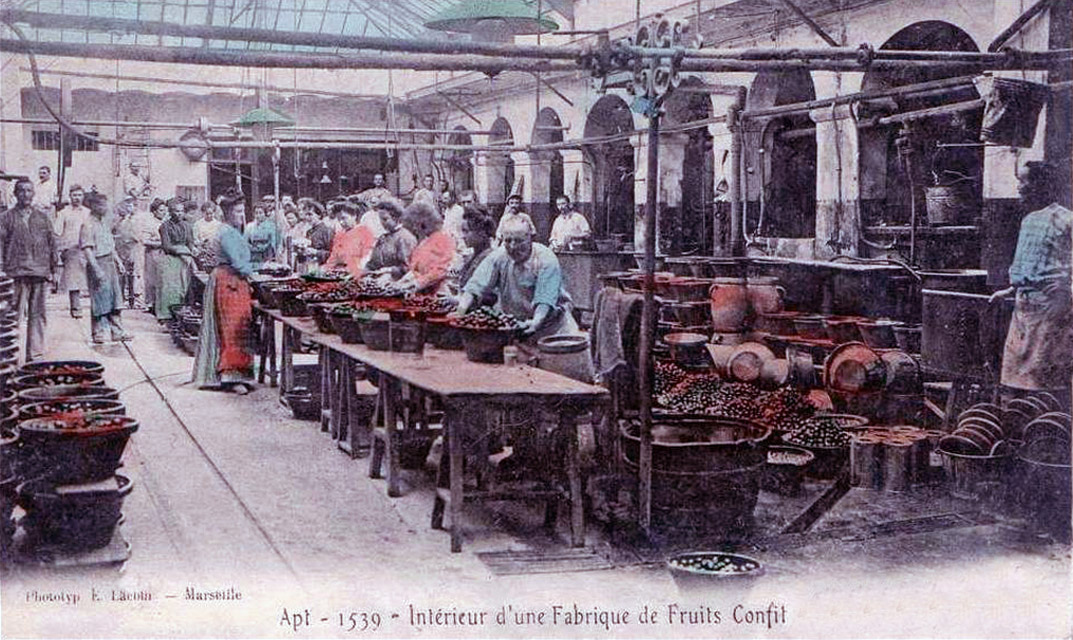
Apt Candied Fruits Factory in 1904. Photo Public Domain via Wikimedia Commons
Notable Apt confectioners emerged, including Jaumard, Rambaud, Marliagues, and others. The industry boomed with the introduction of beet sugar and technological advancements, although international competition gradually overshadowed Apt's production.
To revive Apt's global presence, six independent confectioners united in 1962 to create Aptunion. Despite several ownership changes until 2012, Aptunion contributed significantly to the industry's growth, enhancing the reputation of Apt's candied fruits. Currently, it employs 250 people across three factories.
The Apt candied fruits market today
As the food industry leans towards industrialisation, consuming candied fruits and the traditional confectioner's trade are becoming increasingly rare. Numerous industrial confectioneries have replaced artisanal shops.
Yet, these artisanal confections remain a niche market: locally cherished, they symbolise regional charm and draw in discerning food enthusiasts and those from countries where such traditional sweets are treasured.
Today, only a handful of artisans and industrialists remain active in this field in the region: Marcel Richaud Confectionery in Apt, Saint-Denis Confectionery in Les Beaumettes (see below), Maison Octave (a jam maker in Gargas), and the factories of Aptunion and Maison Marliagues.
![Apt Market © Jula2812 - licence [CC BY-SA 4.0] from Wikimedia Commons Apt Market © Jula2812 - licence [CC BY-SA 4.0] from Wikimedia Commons](https://frenchmoments.eu/wp-content/uploads/2024/01/Apt-Market-©-Jula2812-licence-CC-BY-SA-4.0-from-Wikimedia-Commons-scaled.jpg)
Candied fruits and Pâtes de fruits at the Apt Market © Jula2812 - licence [CC BY-SA 4.0] from Wikimedia Commons
The varieties of fruits used for candying
When it comes to candying, choosing the right fruit is key. Certain varieties are particularly well-suited for this process, capable of being fully soaked in sugar and achieving that unique translucent and luminous look of candied fruit:
- Apricots: the 'Rosé de Provence' from Apt and Roussillon.
- Pears: 'Cérésine', 'Alpes Sarteau', and 'Martin-Sec'.
- Clementines.
- Figs: the 'Petite Marseillaise'.
- Cherries: Vaucluse's Griotte and Bigarreau Hedelfingen.
- Plums: 'Prune de Brignoles' and 'Perdrigonne'.
- Kenyan and Martinique pineapples.
- Angelica from Clermont-Ferrand.
- The 'Prescott' melon from Saint-Martin-de-Castillon, which is more flavourful than the 'Charentais' melon.
- The Corsican 'Chinois', which is a variety of small grapefruits.
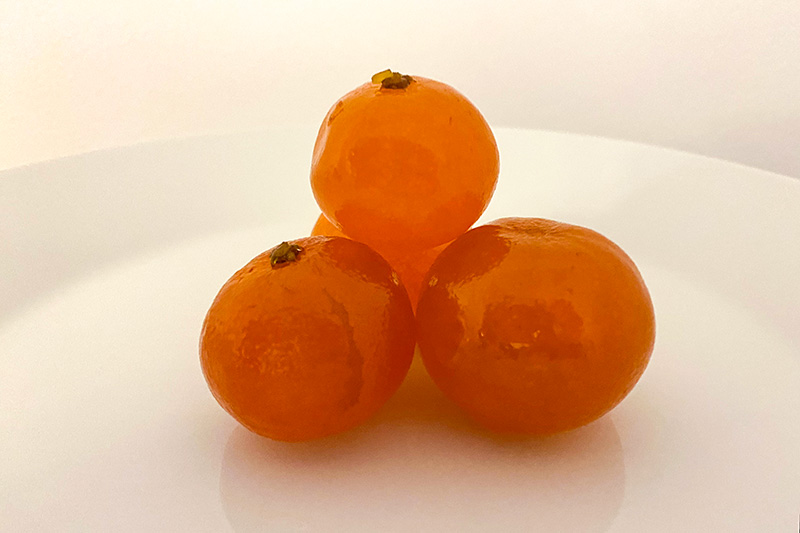
Candied clementines from Confiserie Saint-Denis © French Moments
Some fruits, like figs, melons, and plums, have sweeter tastes, while others, like citrus fruits, offer a hint of bitterness. Interestingly, 75% of these fruits come from Vaucluse, with the remaining 25% being imported.
The candying process
Making candied fruit, or 'confisage', is all about replacing the water in the fruit with cooked sugar. This preserves the fruit and retains most of its flavour, a technique defined at the 1909 International Congress for the Suppression of Fraud. It's a classic example of osmosis.
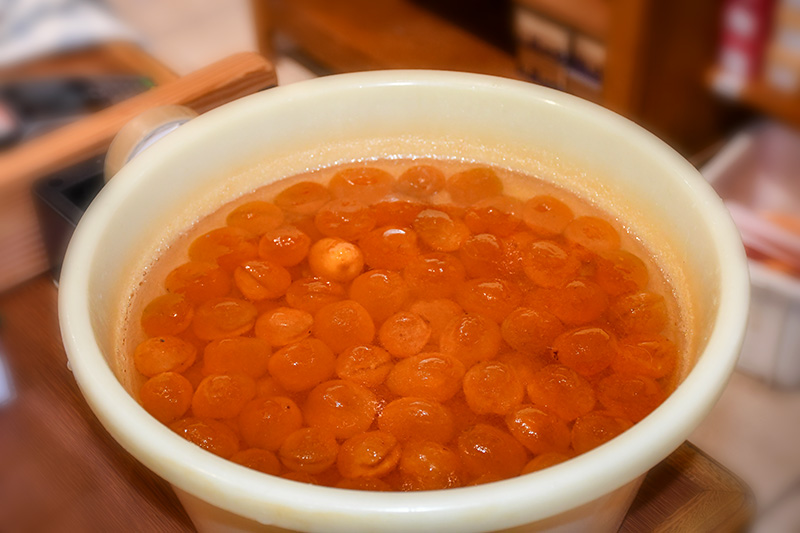
Preparation of the Apt candied fruits in Confiserie Saint-Denis © French Moments
Let's break down the artisanal process of fruit candying:
- Peeling and Pitting: Artisan confectioners start by peeling and pitting the freshly selected seasonal fruits.
- Blanching or 'blanchie': The fruits are briefly boiled (except for strawberries) and then refreshed in several clear water baths. This step removes microbes and yeasts, removes any traces of sulphur, and loosens the plant fibres. This prepares the fruits for sugaring by relaxing their fibres, allowing sugar to penetrate inside. The fruits are then cooled and drained.
- Candying or 'confisage': This is the most delicate stage. The fruits undergo fifteen cookings over a month, about every other day. These repeated cookings expel water from the fruit, gradually replacing it with sugar.
- Final Stage: The fruits rest in their syrup and basin for 6 to 8 months before being sold.
- When ready to sell, artisan confectioners offer them drained or glazed. Glazing or 'glaçage' involves covering the fruit with a sugar shell, making packaging easier.
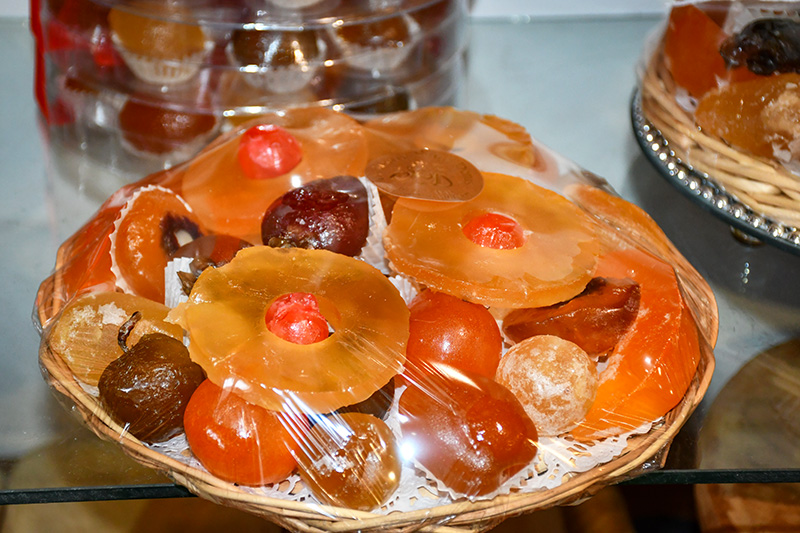
Apt candied fruits by Confiserie Saint-Denis © French Moments
Apt Candied Fruits from the Saint-Denis Confectionery
While searching for an artisanal candied fruit confectionery in Apt, we discovered that only two remain in the Apt region. One is in Apt itself (Confiserie Marcel Richaud), and the other, the Saint-Denis Confectionery, is a 20-minute drive away at the entrance to the village of Les Beaumettes, towards Cavaillon.
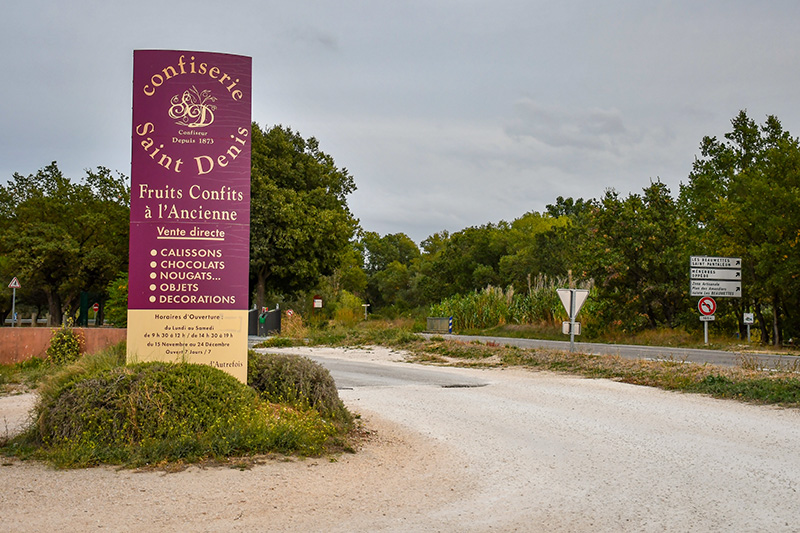
The site of the Confiserie Saint-Denis in La Beaumette © French Moments
A generation of confiseurs
Since 1873, the Saint-Denis family has passionately crafted candied fruits. Initially based in Gargas, they moved to Les Beaumettes in 2003. Holding tightly to tradition, they've maintained the same artisanal methods across decades, passing their expertise down through generations.
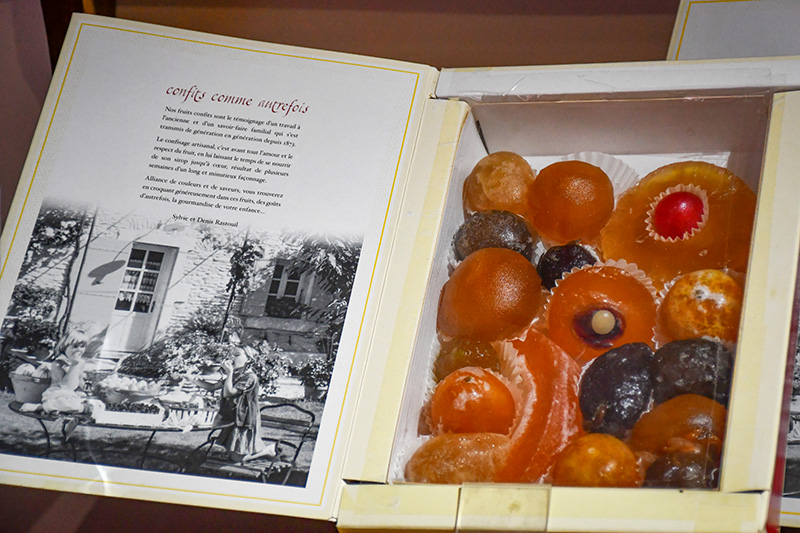
Confiserie Saint-Denis © French Moments
To create top-quality confections with explosive yet gentle flavours, Saint-Denis sources high-quality fruits, often local, depending on the harvest and season.
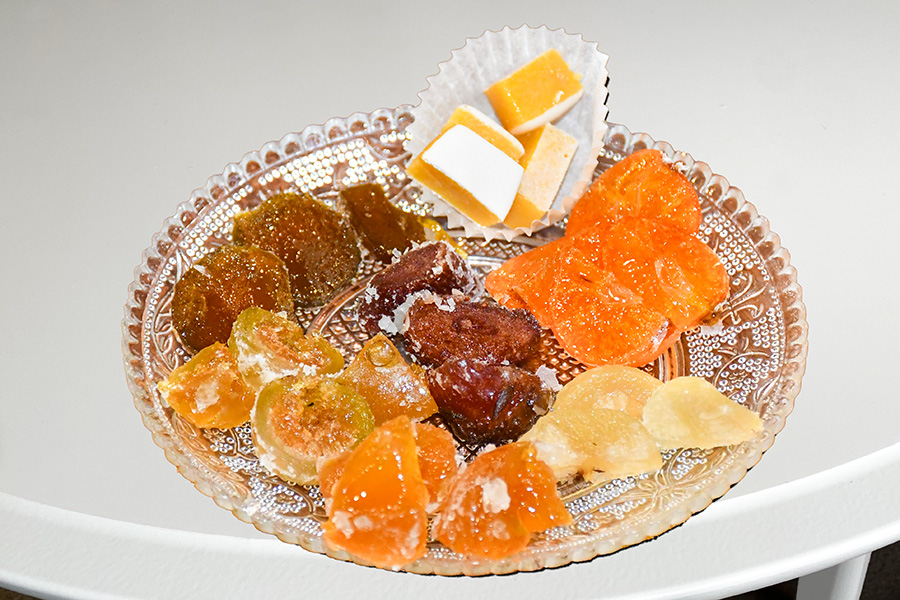
Apt Candied Fruits by Confiserie Saint-Denis © French Moments
During our visit in October, we received a warm welcome. The artisans shared their love for their craft, offering us unique taste recommendations, explaining their manufacturing process, and letting us sample their products.
We bought delicious candied clementines and little candied fruit cubes, perfect for our Christmas leckerlis.
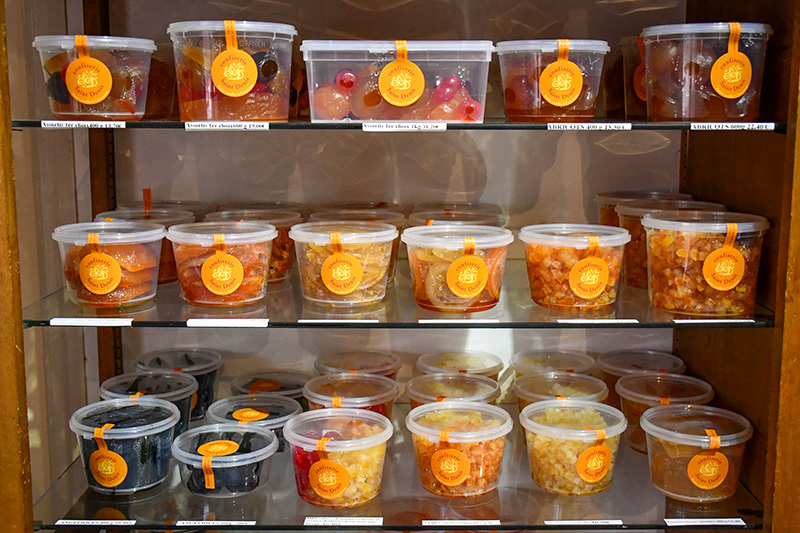
Confiserie Saint-Denis © French Moments
A treasure trove for foodies
The shop in Les Beaumettes is a treasure trove for foodies. Apart from the fantastic Apt candied fruits, you'll find exquisite chocolates with delicate flavours that delight both kids and adults, along with nougats, berlingots, and Aix calissons. There are also Provençal-style home decor items like ceramics, ironworks, and stationery.
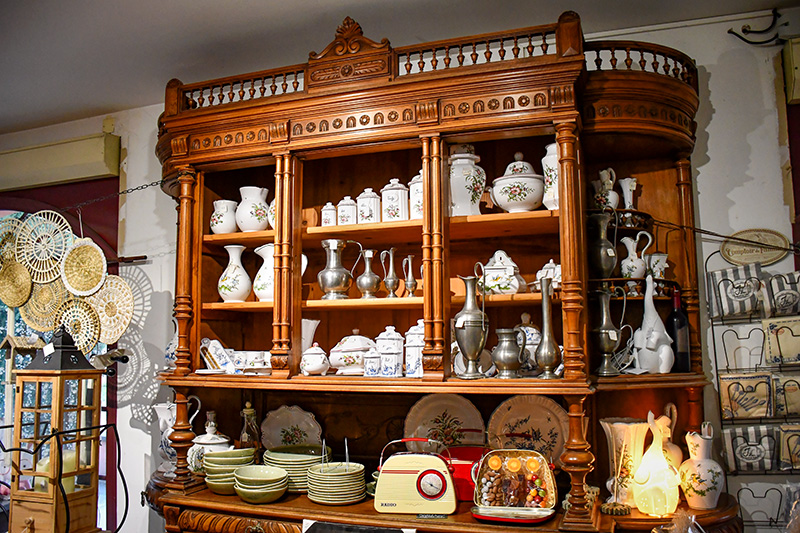
In the shop of the Confiserie Saint-Denis © French Moments
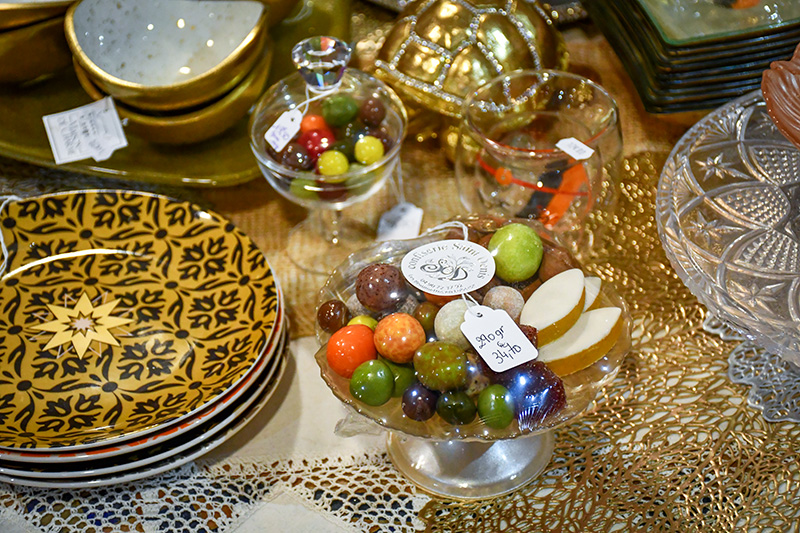
Confiserie Saint-Denis © French Moments
Read more
Check out these links for more information:
- Confiserie Saint-Denis, Zone Artisanale "Le plan des Amandiers" in Les Beaumettes
- Calissons d'Aix, an other delicious sweet delight from Aix-en-Provence
- Christmas in Provence: Traditions and celebrations, including the 'thirteen desserts of Christmas'
- The Luberon: the most beautiful sites and hilltop villages
- Discover the market town of Apt on the blog
Like it? Share it!
Did you enjoy reading about the Apt candied fruits? If so, share this article on Facebook and X (formerly Twitter) or pin this picture on Pinterest:
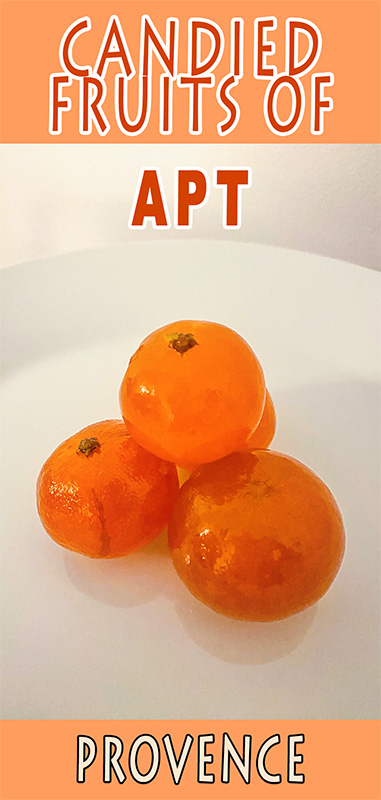


![Apt Candied Melons © Véronique PAGNIER - licence [CC BY-SA 3.0] from Wikimedia Commons Apt Candied Melons © Véronique PAGNIER - licence [CC BY-SA 3.0] from Wikimedia Commons](https://frenchmoments.eu/wp-content/uploads/2013/04/Apt-Candied-Melons-©-Véronique-PAGNIER-licence-CC-BY-SA-3.0-from-Wikimedia-Commons-scaled.jpg)

![Candied Melon © Arnaud 25 - licence [CC BY-SA 4.0] from Wikimedia Commons Candied Melon © Arnaud 25 - licence [CC BY-SA 4.0] from Wikimedia Commons](https://frenchmoments.eu/wp-content/uploads/2013/04/Candied-Melon-©-Arnaud-25-licence-CC-BY-SA-4.0-from-Wikimedia-Commons.jpg)


